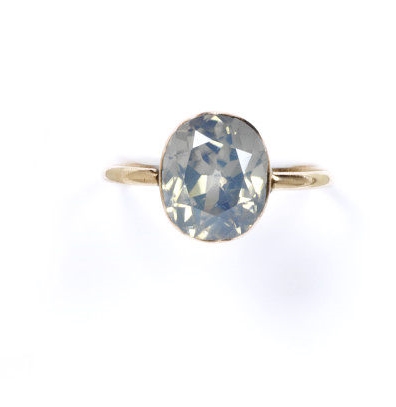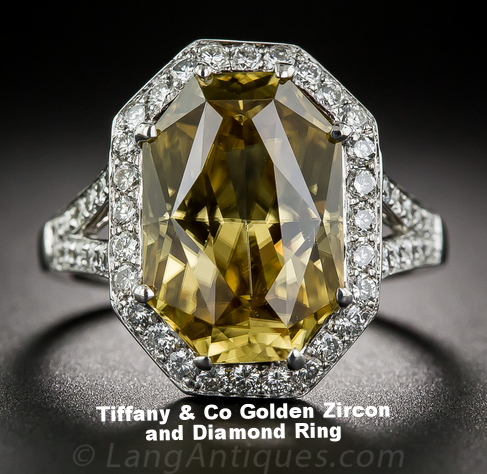Zircon
/We are marking the end of the year with another of December’s birthstones: Zircon
In the past when many people heard the word “zircon” (a naturally occurring gemstone) they immediately jumped to something more familiar, “cubic zirconia” (a man-made diamond simulant). In the current market, consumers have become more savvy in understanding that there is a difference; however, even though many people may have heard of zircon very few have ever encountered it.
Some gemologists classify zircons into three types—high, intermediate, and low.
The majority of zircon is generally of the low and intermediate variety. This is directly related to the chemical makeup of zircon. Zircon a zirconium silicate containing trace amounts of the radioactive minerals hafnium, uranium and thorium. Over time, these radioactive components can break down and destroy the internal lattice of the crystal (over tens of thousands of years). This leaves the zircon with an amorphous structure that has a pithy appearance. “Intermediate” zircon is also exposed to the damaging effects of radiation but to a lesser extent than low zircon.
Virtually all zircon that is used in jewelry is of the “high” variety. Zircon that is of the “high” variety is geologically “young” and virtually unaffected by radioactivity. These high zircons have full crystal structures and as a result, they have the normal physical and optical properties which are compatible with faceting. "High" zircon can also be heat treated to create colorless, blue or golden stones.
The many colors of Zircon Photo courtesy of GIA
The stone comes in a beautiful array of colors including warm browns and lovely shades of cinnamon, sherry, yellows, oranges, and reds. The most well known of the colors are the vibrant bright blues (which may be enhanced by heat treatment). It has been estimated that approximately 80% of all zircons sold are blue, and usually command a slightly higher price. Blue topaz is often offered as a less expensive alternative.
In the early 1900s zircon was often used as a diamond simulant. Due to its doubly refractive nature, zircon displays a high amount of “fire”, even greater than that of diamond, adding to the appeal of the stone. As new technology emerged it was replaced with more convincing look-alikes including many imitations, and it’s name still brings to mind the word “imitation today”. This is sad because zircon is a beautiful stone with a wide range of colors and its own charming history and lore.
"Many scholars think the stone’s name comes from the Arabic word zarkun, meaning 'cinnabar' or 'vermilion.' Others believe the source is the Persian word zargun, or 'gold colored.' Considering zircon’s color range, either derivation seems possible.” (GIA).
In the Middle Ages, zircon was believed to aid in sleep, keep away evil spirits, and promote riches, honor, and wisdom.
Blue zircon especially was a favorite of the Victorian Age. Zircons are usually relatively free of inclusions, but many untreated zircons may have a cloudy or smoky appearance. If it’s very noticeable, this can negatively affect price. In Victorian times, this smokiness made zircon a popular gem for mourning jewelry.
The majority of modern zircon that is used in jewelry will not have eye visible (visible to the naked eye) inclusions. Long, parallel, visible inclusions can make the stone desirable when it is cut into a cabochon because it may create the cat’s-eye effect.
It’s a challenge to cut zircon because the gem is brittle. Cutters usually fashion zircon in the brilliant style to take advantage of its luster and fire. In the past, cutters developed a modification of the brilliant cut, known as the “zircon cut,” which uses eight extra facets around the pavilion (the gem's lower portion). In modern times this is rarely seen, as the added labor required makes it not cost effective. Zircon can also be found in step cuts (rows of parallel facets), and mixed cuts (a combination of brilliant and step-cuts).
The fact that the gemstone has been passed over for so long is an absolute shame. Gemologist and author/researcher George Kunz (a famed gemstone buyer for Tiffany & Company) attempted to rename the stone “starlite”, owing to zircon’s high fire, to promote the gemstone. However, the name failed to catch on and over time the stone seemed to fall by the wayside. There may be a potential upside to the relative obscurity of zircon though. Analysts in the gem industry have stated that zircon has yet to reach its full potential in value, and it will only appreciate in value so it may be an excellent time to branch out and embrace the beauty of zircon.
The final word:
Zircon is Not Cubic Zirconia! Zircon is a naturally occurring mineral found in the earth. Cubic zirconia is a man-made diamond simulant. They have both been used in place of diamonds, though cubic zirconia is used much more commonly than zircon in modern times. The differences are easy for a trained gemologist to spot. When in doubt ask an independent gemologist.
Basic Information:
Formula: ZrSO4, May contain minor U, Th, Pb, Hf, Y/REE, P and others.
Crystal Systems: Tetragonal
Hardness: 7-1/2
Color: Yellow, Clear, Blue, Pink, Brown...etc
Lustre: Adamantine, Vitreous, Greasy
Mineral Group: Zircon
Major sources: Major sources of zircon are the Chanthaburi area of Thailand, the Palin area of Cambodia, and the southern part of Vietnam.
Misc: Eye visible, strong double refractivity. This causes high fire that is more noticeable in light colored stones but may be seen even in darker stones.




















